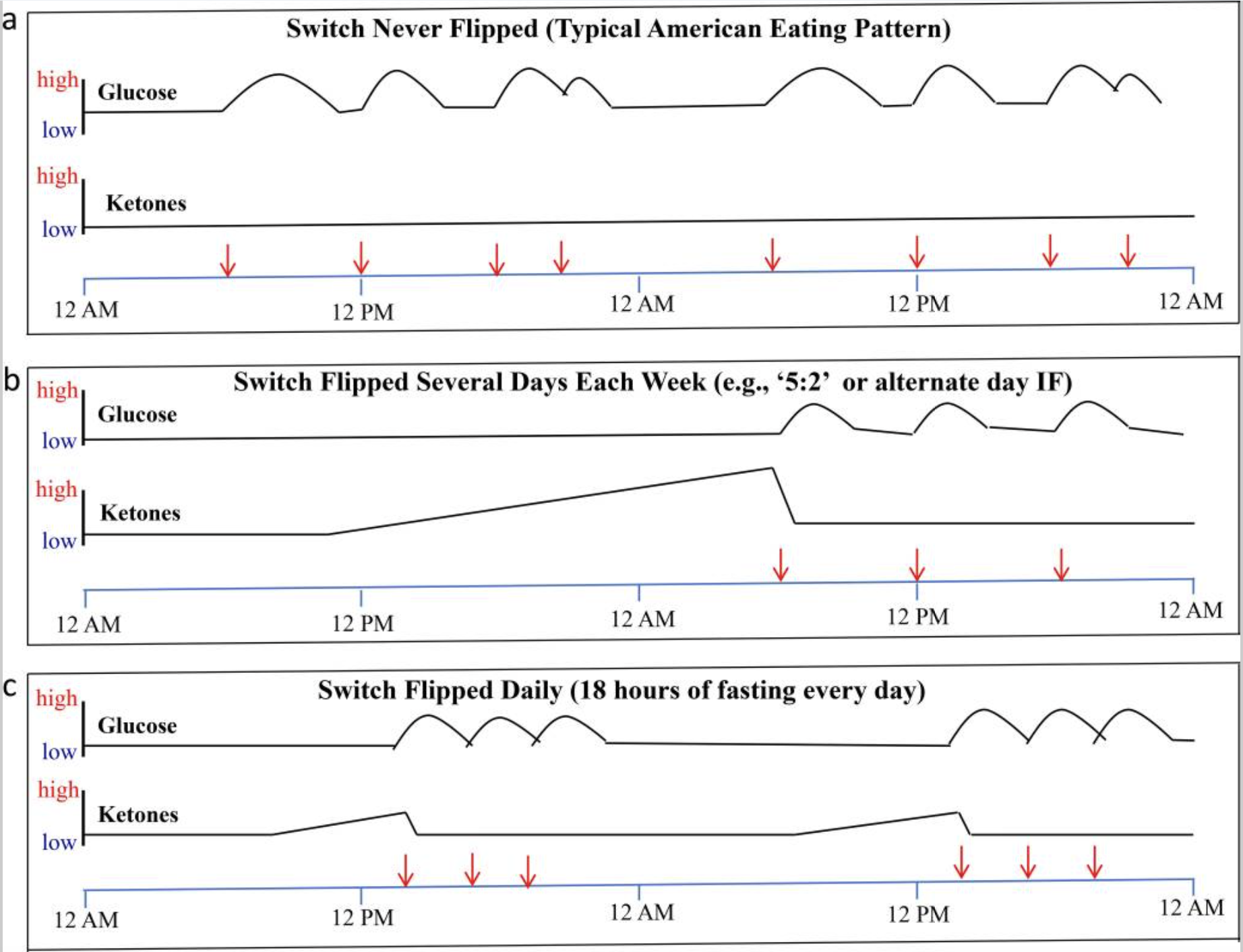Just like the ketogenic diet, intermittent fasting (IF) continues to grow in popularity, with many overlapping features and applications. Many people boast about intermittent fasting for weight loss, mental clarity, productivity, better sleep, the list goes on. However, “intermittent fasting” is an umbrella term for several variations of fasting. There’s time-restricted eating (TRE), alternate-day fasting (ADF), extended and multi-day fasts. Technically these are all forms of intermittent fasting despite producing different physiological responses (and degrees of energy deficit) , and as you can imagine, there are infinite variations of IF. The most common, and perhaps most practical of these is TRE, which will be the focus of this article. However, we wanted to provide some background information on all these different forms of fasting for better understanding on where TRE fits in.

What is Time-Restricted Eating?
Time-restricted eating, or TRE for short (also referred to as time-restricted feeding, or TRF), is just as it’s name suggests: eating in a restricted time frame. This form of IF takes place within a 24-hour window and can be practiced daily which differentiates it from other forms of IF. The term TRE/TRF was coined by Dr. Satchin Panda of the Salk Institute for Biological Studies when his lab found that mice were protected from the metabolic deranging effects of an obesogenic diet when they simply consumed food within restricted hours of the day. The most remarkable thing was that these positive benefits occurred (at least in mice), even when calories were matched! TRE simply involves consuming all daily calories within at most a 12-hour, but often less, window of time allowing for a daily extended fast of at least 12-hours. The most common form of TRE is 16:8, whereby eating takes place within an 8-hour window.
What is Alternate Day Fasting?
Alternate day fasting, or ADF, is a form of IF that involves eating one day, and fasting another. This form of IF has actually been studied quite a bit despite it being potentially impractical for many people. Oftentimes, there is an allowance of up to 500 calories (0-25% of caloric needs) on the “fasting” days. ADF has been shown to produce similar weight loss to daily caloric restriction in obese adults, however, a more recent study suggests that ADF may be inferior to daily caloric restriction for body composition changes, as ADF led to significantly greater loss in lean mass (muscle). Though, there are ways to maintain muscle mass whilst in a caloric deficit and even fasting, such as resistance training, which is a powerful stimulus for skeletal muscle retention. Altogether, ADF can help one lose weight by producing an overall energy deficit, but should be strategically implemented to promote favorable changes in body composition (fat loss > muscle loss). Theoretically, this ADF approach could be optimized for body composition by adding resistance training and ensuring adequate protein (1.5 g/kg ideal bodyweight) on feeding days, and 500 calories protein (0-25% of caloric needs) on the “fasting” days.
What is an Extended or Prolonged Fast?
Prolonged fasts are often defined as fasting lengths of 48-hours and beyond. There is no clear definition of an extended fast, but in our opinion, any fast extending beyond 24-hours would fall into this category. It is not uncommon for people to practice periodic 36-hour fasts, some even do these weekly. Fasting beyond 24-hours will lower blood glucose and insuiln, deplete iver glycogen, and send our metabolism into ketosis, which is one reason many people choose to fast. Ketones will progressively rise during the initial ~5-7-days of a prolonged fast, and eventually plateau when your body has reached a new homeostasis and is comfortably burning fats and ketones as fuel. Prolonged fasts are often used for therapeutic purposes to upregulate autophagy and suppress our “pro-growth” pathways that contribute to cancer cell growth.
What are the benefits of TRE?
As mentioned, the focus of this article is to discuss the rationale for and research on TRE. Recently, Dr. D’Agostino had the opportunity to chat with Dr. Panda on his TRE research, which you can check out here: https://www.youtube.com/watch?v=78-kwh_GtWY
What often gets overlooked are the health benefits and lifestyle of TRE that extend beyond energy balance (aka, calories in vs calories out). One perspective is to think of TRE simply as a tool to create a caloric deficit, which it does for many! Many metabolic benefits, of course, are those associated with the TRE-induced caloric restriction. However, emerging data suggest that the benefits of TRE can extend much further.
TRE for Weight Loss and Cardiometabolic Health
When it comes to weight loss and improving metabolic health, TRE can be a fantastic strategy. A 2020 meta-analysis showed that TRE does produce significant weight loss, all whilist improving fast blood glucose levels, blood pressure, and blood lipids. However, unlike in mice, when compared to eating in a caloric deficit with unrestricted time, TRE does not seem to produce any additional weight loss. So, it’s important to recognize that there doesn’t seem to be anything magical about TRE for weight loss that isn’t simply the result of caloric restriction. It also means that you can’t just gorge on whatever you want during the eating window and think that your daily fast is all that’s needed for weight loss. We highlighted this point in a previous blog post where TRE didn’t lead to significant weight loss when participants were simply told to restrict their eating to 8-hours. What you eat, and how much you eat matter! What does seem to be the case, however, is that TRE can advertently, or inadvertently, create a caloric deficit, and thus lead to weight loss. So, if you find sticking to TRE prevents you from snacking on chips and ice cream at night, and helps you lose weight or maintain a healthy body composition easier than just counting calories, then that is fantastic and you should stick with it! Being at a healthy body weight and leaner body composition greatly augments metabolic health, and often they move together in parallel.
TRE for Circadian Alignment

Now we are getting to the inherent potential benefits of TRE that have nothing to do with body weight. A large rationale for TRE, whereby the eating window takes place during waking/active hours of the day in alignment with the cycles of the sun, is for the benefits this can have on our circadian clocks. See, our bodies and metabolism function on a circadian rhythm, or 24-hour cycle, and these rhythms orchestrate nearly every physiological process in the body, including our metabolism. This means there are times when our body is ready to digest food, and times when it would prefer to rest. Light is our primary time-keeper and entrains our master circadian clock located in the brain, however, Dr. Panda’s work shows that when we eat can alter the expression of genes involved in metabolism. Ideally, the clocks entrained by light and the clocks entrained by food align in perfect synchrony as there is overlaps between the two. For example, light impacts the production and release of our sleep hormone, melatonin, but melatonin also interacts with the pancreas and tells the pancreas it’s time for rest. If we eat when our pancreas is checked out for the day, this could lead to impaired insulin secretion and unfavorable glucose responses to food. Because of this, circadian researchers recommend avoiding meals 2-3 hours before regular bedtime. This may also have benefits on sleep quality, which further support our circadian clocks and metabolic health. Since circadian desynchrony is associated with metabolic derangement, having all our clocks aligned may be very important for metabolic health. More research is needed in humans, but in mice, a consistent fasting/feeding schedule that aligns with the day/night cycle supports robust circadian rhythms and protects against the development of obesity and related metabolic disorders.
TRE for Metabolic Switching
Much of the magic of intermittent fasting is thought to occur due to metabolic switching, which essentially describes the switch from primarily glucose-based metabolism to fats and ketones. (Note: Dr. Mark Mattson coined the term and writes about it here). The theory is that making this metabolic switch regularly, in this case, daily, promotes greater metabolic flexibility. Metabolic flexibility is a critical component of overall metabolic health. Metabolic inflexibility on the other hand is associated with metabolic disease. In addition, if daily fasts are long enough (likely beyond 16-hours) or paired with either caloric restriction, exercise, or a very low carbohydrate ketogenic diet, then one would be cycling into ketosis on a daily basis. We have several other blog posts on the benefits of ketones, so we encourage you to check those out if you are interested! Therefore, the benefits of TRE could be in part due in-part to the production, presence and signaling effects of ketones.

Source: Anton et al., 2018, https://www.ncbi.nlm.nih.gov/pmc/articles/PMC5783752/
TRE for Mental Clarity and Productivity
Another potential benefit to TRE is the practical benefit of not having to think about, preparing, or eating food through certain hours of the day. For example, if you wake up at 6am and don’t eat until noon, that’s a lot of uninterrupted time to stay focused and get work done. This is not an unusual schedule for many intermittent fasters. In addition, extending a fast throughout the busy work hours, while not for everyone, can be where a little boost in ketones shine for cognitive function and productivity. Ketones are an excellent fuel source for the brain, and people may gravitate towards a TRE schedule simply for the practicality and mental benefits they receive. As Dom has discussed previously blogs and numerous podcasts, there is considerable freedom and logistical/productivity advantages to reducing the feeding window, and after a few weeks of TRE most people report feeling more alert and energetic, especially within the 4-6 hrs of fasting prior to entering the feeding window.
How to Get Started with TRE
Restricting eating to less than 12-hours of the day is doable for almost anybody, and arguably something we could all stick to. There are few exceptions such as elderly who may need more time to allow for the consumption of adequate nutrition, in addition to children and high-level athletes. For the general public, however, TRE is a form of IF that could benefit most, importantly when paired with a whole-foods nutritious diet. For those who already follow a ketogenic diet, IF will likely be very easy to adopt due to your body already being used to being in that fat-burning state, as nutritional ketosis mimics fasting in a lot of ways! If you are just getting started with TRE, start slow, perhaps with a daily 12-hour fast, cutting out those late night snacks and eventually shortening the window over a few weeks to ~16-hour daily fasts, for example eating from 11am-7pm. In addition, it is important to choose an eating window that fits with your lifestyle, including family eating schedules when you workout, etc., and to keep your eating schedule as regular as possible because of how it affects our metabolic clocks. Lastly, try your best to start your fast 2-3 hours before your usual bed time.
Conclusion
To wrap things up, there are many different variations of intermittent fasting. Some practiced daily, and others practiced maybe only once a year! Eating within a compressed feeding window each day with TRE can promote better overall health through the reduction in caloric intake, improved metabolic biomarkers, optimal circadian rhythm and sleep, and numerous benefits associated with greater metabolic flexibility and elevated ketone levels.
